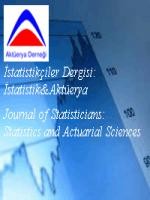Çarpık Normal Dağılımlı AR(1) Modeli İçin Dayanıklı Kontrol Kartları
Geleneksel kalite kontrol kartlarının dayandığı iki temel varsayım söz konusudur. Bunlardan ilki verilerin birbirinden bağımsız olması, ikincisi normal dağılıma sahip olmasıdır. Ancak günümüzde üretim süreçlerinin ve numune alım hızlarının artması nedeniyle süreçten gelen veriler otokorelasyonlu olmaktadır. Otokorelasyon sorununun üstesinden gelmek için verilere uygun bir model uydurularak, artıklara dayalı kalite kontrol grafiği çizilebilir. Ayrıca veriler üretim hızından dolayı normal dağılımdan daha çarpık bir dağılıma uyum gösterebilir. Literatürdeki çalışmaların büyük kısmı ya sadece otokorelasyonlu veriler için yada normal dağılıma sahip olmayan veriler için istatistiksel süreç kontrol tekniklerine odaklanmıştır. Aynı anda hem otokorelasyon problemini hemde normal olmayan dağılımlara ilişkin süreç kontrolünü ele alan çok az çalışma mevcuttur. Bu çalışmada her iki problemi aynı anda ele alan AR(1) sürecine uygun çarpık normal dağılımlı veriler için kalite kontrol grafikleri incelenmiştir. Ele alınan tüm kontrol kartları ARL değerlerine dayalı bir simülasyon çalışması ile karşılaştırılmıştır. Sonuç olarak, sağlam S_n tahmin edicisine dayalı kontrol grafiğinin kullanılmasının yanlış alarm olasılığını azalttığı tespit edilmiştir.
Anahtar Kelimeler:
Çarpık normal dağılım, Kontrol kartı, Otokorelasyon, Sağlam tahmin ediciler.
Robust control charts for Ar(1) model with skew normal distribution
There are very few studies in the literature that address both the autocorrelation problem and the process control of non-normal distributions. In this study, we examined quality control charts for skewed normal distribution data in accordance with the AR(1) process, which handles both problems simultaneously. We compared the considered control charts over a simulation study that is based on ARL values. As a result, we found that the use of the control chart based on the robust S_n estimator reduces the probability of false alarms.
___
- [1] Işığıçok, E. (2012). Toplam kalite yönetimi bakış açısıyla istatistiksel kalite kontrol, Bursa: Ezgi Yayınevi. [2] Montgomery, D.C., 2009, Introduction to Statistical Process Control, John Wiley & Sons, Inc., p.13. [3] Birgören, B., 2015, İstatistiksel kalite kontrolü. Ankara: Nobel Akademik Yayıncılık.
- [4] Shewhart, W.A., 1931, Economic Control of Quality of Manufactured Product, American Society for Quality Control, p.145. [5] Qui, P., 2013, Introduction to Statistical Process Control, Texts in Statistical Science, p.74. [6] Öztürk, A., 2009, Kalite yönetimi ve planlaması. Bursa:Ekin Yayınları. [7] Bai, D.S., Choi, I.S., 1995, X ̅ and R control charts for skewed populations, Journal of Quality Technology, 27,2, 120-131.
- [8] Karaoğlan, A. D., 2010, CONTROL CHARTS FOR AUTOCORRELATED PROCESSES: A REVIEW Engineering Sciences, 5(2), 243-25.
- [9] Karaoğlan, A., Bayhan, G., 2011, Performance Comparison of Residual Control Charts for Trend Stationary First Order Autoregressive Processes, Gazi University Journal of Science, 24(2), 329-339.
- [10] Tsai, Tzong-Ru., 2007, Skew normal distribution and the design of control charts for averages, International Journal of Reliability, Quality and Safety Engineering, 14,1, 49- 63.
- [11] Tsai, Tzong-Ru., Chiang, Jyun‐You., 2008, The design of acceptance control chart for non-normal data, Journal of The Chinese Institute of Industrial Engineers, 25:2, 127-135.
- [12] Li, Chung-I., Su, Nan-Cheng., Su, Pei-Fang., Shyr, Yu., 2014, The design X ̅ of and R control charts for skew normal distributed data, Communications in Statistics - Theory and Methods, 43:23, 4908-4924.
- [13] Li, C., Mukherjee, A., Su, Q., Xie, M., 2019, Some monitoring procedures related to asymmetry parameter of azzalini’s skew-normal model. Revstat - Statistical Journal, 17,1, 1-24.
- [14] Figueiredo, F., Gomes, M.I., 2013, The skew-normal distribution in SPC, Revstat – Statistical Journal, 11,1, 83-104.
- [15] Alwan, L.C., Roberts, H.V., 1988, Time-series modeling for statistical process control, Journal of Business & Economic Statistics, 6(1), 87–95.
- [16] Thomas R. Willemain, George C. Runger, 1996, Designing Control Charts Using an Empirical Reference Distribution, Journal of Quality Technology, 28:1, 31-38.
- [17] Ma, X., Zhang, L., Hu, J., Palazoglu, A., 2018, A model-free shewhart individuals control chart for autocorrelated data, 10th IFAC International Symposium on Advanced Control of Chemical Processes, Chine, July 25-27.
- [18] Mishra, U., Singh, J.R., 2020, Effect of first order auto-regressive model on the power function of average control charts under non-normal population, Sri Lankan Journal of Applied Statistics, 21(2), 26–37.
- [19] Gorgin, V., Gildeh, B.S., 2020, MAD control chart for autoregressive models with skew-normal distribution, Stochastics and Quality Control, 35,1, 17-23.
- [20] Choobineh, F., Ballard, J.L., 1987, Control-limits of QC charts for skewed distributions using weighted-variance, IEEE Transactions on Reliability, R-36,4, 473-477.
- [21] Chang, Y.S., Bai, D.S., 2001, Control charts for positively-skewed populations with weighted standard deviation, Quality and Reliability Engineering International, 17, 397-406.
- [22] Chan, L.K., Cui, H.J., 2003, Skewness correction X ̅ and R charts for skewed distributions, Naval Research Logistics, 50, 555 – 573.
- [23] Tukey, J.W., 1960, A Survey of Sampling from Contaminated Distributions. In: Oklin, I., Ed., Contributions to Probability and Statistics, Stanford University Press, Redwood City, CA.
- [24] Hoaglin DC, Mosteller F, Tukey JW, eds, 2000, Understanding Robust and Exploratory Data Analysis. New York: Wiley-Interscience.
- [25] Wilcox, R., 2012, Introduction to robust estimation and hypothesis testing. 3rd ed. [26] Riaz, M., 2008, A dispersion control chart, Communications in Statistics - Simulation and Computation, 37:6, 1239-1261.
- [27] Goldberg, K. M., Iglewicz, B., 1992, Bivariate Extensions of the Boxplot. Technometrics, 34(3), 307–320.
- [28] Rousseeuw, P.J., Croux, C., 1993, Alternatives to median absolute deviation, Journal of the American Statistical Association, 88:424, 1273 - 1283.
- ISSN: 1308-0539
- Yayın Aralığı: Yılda 2 Sayı
- Başlangıç: 2008
- Yayıncı: Aktüerya Derneği
